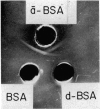Abstract
The i.p. immunization with chemically modified antigen (dodecanoyl-bovine serum albumin, d-BSA) emulsified in Freund's incomplete adjuvant (FIA) of CBA mice provoked delayed-type hypersensitivity (DTH), but not any detectable formation of antibody to the original antigen (BSA). Furthermore, it was found that immunization with d-BSA could generate T cells capable of inhibiting the antibody response to hapten on BSA, and the immunosuppressive effects of these T cells were presumably not due to direct action on hapten-primed and antibody producing B cells. These results were obtained from the following experiments: (1) anti-hapten antibody response to dinitrophenylated-BSA (DNP-BSA) was inhibited when the mice had been primed previously with d-BSA in FIA. This inhibition was regulated by the specificity of the carrier, since the mice treated with d-BSA did not inhibit the anti-DNP antibody response after the immunization with DNP-heterologous carrier, i.e. DNP-keyhole limpet haemocyanin (DNP-KLH). (2) The passive transfer of spleen cells, which had been obtained from donors primed with d-BSA in FIA, inhibited the primary anti-DNP antibody response of syngeneic mice after immunization with DNP BSA. (3) Injection of d-BSA-primed spleen cells suppressed an adoptive anti-DNP antibody response in mice which had been irradiated and had previously had their immunocompetence reconstituted by the cell transfers with both DNP-primed and BSA-primed spleen cells. This in vivo immunosuppressive effect of d-BSA-primed spleen cells did not act on hapten-primed B cells, since d-BSA-primed spleen cells could not suppress the adoptive secondary antibody response reconstituted by DNP-primed cells and bacterial alpha-amylase (BαA)-primed cells. This finding suggests that a T—T cell interaction exists for the suppression of the anti-DNP antibody response to DNP-BSA by d-BSA-primed cells.
Full text
PDF








Images in this article
Selected References
These references are in PubMed. This may not be the complete list of references from this article.
- Asherson G. L., Stone S. H. Selective and specific inhibition of 24 hour skin reactions in the guinea-pig. I. Immune deviation: description of the phenomenon and the effect of splenectomy. Immunology. 1965 Sep;9(3):205–217. [PMC free article] [PubMed] [Google Scholar]
- Basten A., Miller J. F., Sprent J., Cheers C. Cell-to-cell interaction in the immune response. X. T-cell-dependent suppression in tolerant mice. J Exp Med. 1974 Jul 1;140(1):199–217. doi: 10.1084/jem.140.1.199. [DOI] [PMC free article] [PubMed] [Google Scholar]
- Cerottini J. C., Nordin A. A., Brunner K. T. Specific in vitro cytotoxicity of thymus-derived lymphocytes sensitized to alloantigens. Nature. 1970 Dec 26;228(5278):1308–1309. doi: 10.1038/2281308a0. [DOI] [PubMed] [Google Scholar]
- Coon J., Hunter R. Selective induction of delayed hypersensitivity by a lipid conjugated protein antigen which is localized in thymus dependent lymphoid tissue. J Immunol. 1973 Jan;110(1):183–190. [PubMed] [Google Scholar]
- Cunningham A. J., Szenberg A. Further improvements in the plaque technique for detecting single antibody-forming cells. Immunology. 1968 Apr;14(4):599–600. [PMC free article] [PubMed] [Google Scholar]
- Gershon R. K., Kondo K. Infectious immunological tolerance. Immunology. 1971 Dec;21(6):903–914. [PMC free article] [PubMed] [Google Scholar]
- Gold E. R., Fudenberg H. H. Chromic chloride: a coupling reagent for passive hemagglutination reactions. J Immunol. 1967 Nov;99(5):859–866. [PubMed] [Google Scholar]
- Gray J. G., Monaco A. P., Wood M. L., Russell P. S. Studies on heterologous anti-lymphocyte serum in mice. I. In vitro and in vivo properties. J Immunol. 1966 Feb;96(2):217–228. [PubMed] [Google Scholar]
- Ha T. Y., Waksman B. H. Role of the thymus in tolerance. X. "Suppressor" activity of antigen-stimulated rat thymocytes transferred to normal recipients. J Immunol. 1973 May;110(5):1290–1299. [PubMed] [Google Scholar]
- Jandinski J., Cantor H., Tadakuma T., Peavy D. L., Pierce C. W. Separation of helper T cells from suppressor T cells expressing different Ly components. I. Polyclonal activation: suppressor and helper activities are inherent properties of distinct T-cell subclasses. J Exp Med. 1976 Jun 1;143(6):1382–1390. doi: 10.1084/jem.143.6.1382. [DOI] [PMC free article] [PubMed] [Google Scholar]
- Kapp J. A., Pierce C. W., Schlossman S., Benacerraf B. Genetic control of immune responses in vitro. V. Stimulation of suppressor T cells in nonresponder mice by the terpolymer L-glutamic acid 60-L-alanine 30-L-tyrosine 10 (GAT). J Exp Med. 1974 Sep 1;140(3):648–659. doi: 10.1084/jem.140.3.648. [DOI] [PMC free article] [PubMed] [Google Scholar]
- Lagrange P. H., Mackaness G. B., Miller T. E. Influence of dose and route of antigen injection on the immunological induction of T cells. J Exp Med. 1974 Mar 1;139(3):528–542. doi: 10.1084/jem.139.3.528. [DOI] [PMC free article] [PubMed] [Google Scholar]
- Liew F. Y., Parish C. R. Lack of a correlation between cell-mediated immunity to the carrier and the carrier-hapten helper effect. J Exp Med. 1974 Mar 1;139(3):779–784. doi: 10.1084/jem.139.3.779. [DOI] [PMC free article] [PubMed] [Google Scholar]
- Lüderitz O., Staub A. M., Westphal O. Immunochemistry of O and R antigens of Salmonella and related Enterobacteriaceae. Bacteriol Rev. 1966 Mar;30(1):192–255. doi: 10.1128/br.30.1.192-255.1966. [DOI] [PMC free article] [PubMed] [Google Scholar]
- Miller T. E., Mackaness G. B., Lagrange P. H. Immunopotentiation with BCG. II. Modulation of the response to sheep red blood cells. J Natl Cancer Inst. 1973 Nov;51(5):1669–1676. doi: 10.1093/jnci/51.5.1669. [DOI] [PubMed] [Google Scholar]
- Okumura K., Tada T. Regulation of homocytotropic antibody formation in the rat. VI. Inhibitory effect of thymocytes on the homocytotropic antibody response. J Immunol. 1971 Dec;107(6):1682–1689. [PubMed] [Google Scholar]
- Tada T., Takemori T. Selective roles of thymus-derived lymphocytes in the antibody response. I. Differential suppressive effect of carrier-primed T cells on hapten-specific IgM and IgG antibody responses. J Exp Med. 1974 Jul 1;140(1):239–252. doi: 10.1084/jem.140.1.239. [DOI] [PMC free article] [PubMed] [Google Scholar]
- Takatsu K., Ishizaka K. Reaginic antibody formation in the mouse. VII. Induction of suppressor T cells for IgE and IgG antibody responses. J Immunol. 1976 May;116(5):1257–1264. [PubMed] [Google Scholar]
- Taniguchi M., Hayakawa K., Tada T. Properties of antigen-specific suppressive T cell factor in the regulation of antibody response of the mouse. II. In vitro activity and evidence for the I region gene product. J Immunol. 1976 Feb;116(2):542–548. [PubMed] [Google Scholar]



